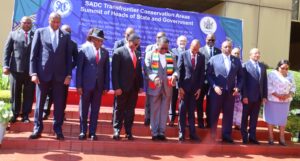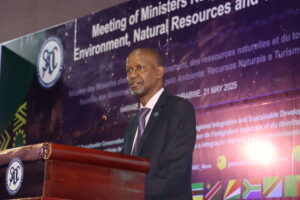

Chakwera with Zimbabwe President Mnangagwa and the other Heads of State.—Pictures by Mary Makhiringa, MANA
* He was responding to Zimbabwe President Mnangagwa call to member countries to adopt science-based approach in environmental conservation
* And to consider taking aboard the youth and women in this cause in winning the battle of conserving wildlife and the environment
By Mary Makhiringa MANA in Harare, Zimbabwe
President Lazarus Chakwera Malawian youths constitutes as the highest in the country’s population, thus he is committed to fully engage and empower the young population in wildlife conservation — thereby winning the battle of conserving wildlife and the environment.
Advertisement
Chakwera said today in an interview with Malawi News Agency (MANA) at the end of the Southern African Development Community (SADC) Transfrontieer Conservation Area (TFCA) Summit held in Harare, Zimbabwe.
He was responding to President Emmerson Mnangagwa of Zimbabwe, who is the current SADC chairperson, when he encouraged member countries to adopt science-based approach in environmental conservation.
In his speech at the 2025 SADC TFCA summit at Rainbow Tower in Harare where Heads to State convened marking 25 years of TFCA in the region, Mnangagwa said the region must also consider taking aboard the youth and women in this cause.



Advertisement
“The youth and women of our countries must play an important role in wildlife conservation, riding on the hard work ethic of this demographic.
“We also need to empower the rural community, because by empowering them and enhancing tourism and promoting cross boarder wall enforcement we have laid a strong foundation for lasting impacts.”
Mnangagwa added that the region is currently boosting of 13 TFCAs with five others on the way, as the region looks towards the next 25 years of doubling its dedication to fostering social ecological and economic connectivity.
“At the centre of these efforts, we need to enhance livelihood of our communities. Today, the TFCAs are safe habitats for wildlife to move away from human settlements, which has helped to reduce human-wildlife conflicts,” he said.

Magosi, SADC Executive Secretary
SADC Executive Secretary, Elias Magosi said SADC TFCA has formed one of the largest conservation areas on the African continent of which the Kavango-Zambia (KAZA) transfrontier arrangement accounts for 520,000 square kilometres.
“Today, we can look back with pride and celebrate the value of effective corroboration of member states who have demonstrated, over time, strong political will and invested in financial and human resources and fostered partnerships to realise this great vision that we are celebrating today.
“The commemoration presents a moment of pride and opportunity for reflection on the successes and challenges in trans-boundary natural resources across our region.”
He emphasised that TFCAs is not only about conservation but also co-existence, development and resilient and regional identity and he further highlighted that SADC TFCA is currently facing deforestation challenges which is necessitating loss of about 0.6% cover every year — which is roughly 31% of Africa’s deforestation area annually, whose primary driver is poverty and population growth.

